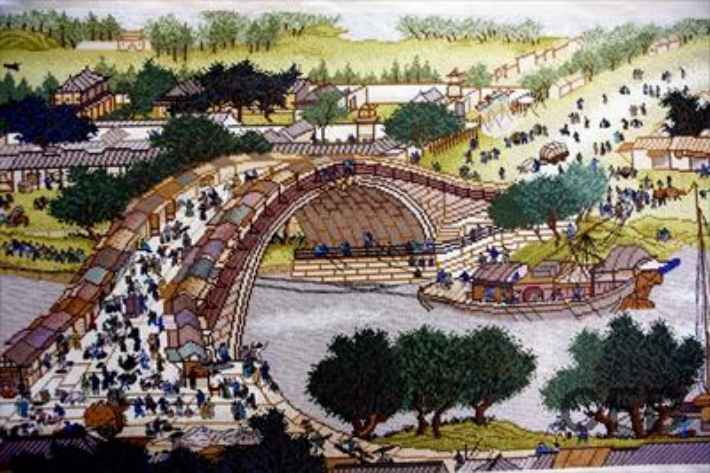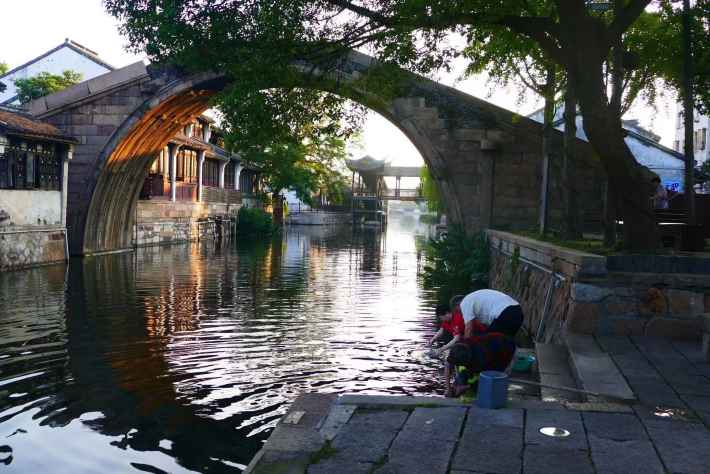Functional and Poetic Chinese Landscape

Over thousands of years, diligent Chinese people have worked the land hard, developing strong reliance and belief in the soil and creating a farming civilization pursuing recycling and sustainability.
To develop agriculture, they continued to explore practices based on the natural conditions of China and its various mountains, rivers and lakes. They built dams and other water conservancy projects to store water, diverted rivers according to local conditions, and dug lakes, canals, and ditches, forging a hydrological network with controllable water storage and discharge functions.

Along the River During the Qingming Festival, a famous painting from the Northern Song Dynasty (960-1127) fully reflects the prosperity and vitality the canal brought to the city. The picture shows part of the cross-stitch work based on this ancient painting, created by Yang Xiaowei from Sichuan Province. (Photo from CFB)
This transformed considerable wastelands in China that were not suitable for agricultural production into fertile farmland, empowering the people to support an increasing number of residents on limited arable land. At the same time, it changed the natural hydrological conditions of China’s densely populated areas, forming the country’s unique landscape in which mountains and rivers are interdependent, artificial and natural views are intertwined, and mountains, rivers, canals, lakes, and fields are integrated.
In the famous landscape painting A Panorama of Rivers and Mountains by Northern Song Dynasty (960-1127) painter Wang Ximeng, continuous mountains and rivers connect villages and settlements in valleys and on hills, reflecting ancient China’s unique rural living environment that was highly integrated with the land.
Chinese cities emerged and developed within the framework of this agricultural civilization. Water systems became infrastructure for water supply, storage, drainage and transportation, influencing the layout of almost every city in ancient times.
In ancient China, water conservancy facilities not only ensured the safety and sustainable development of cities, but also built a natural system that ran throughout the cities, shaping the urban spatial structure and landscape pattern integrating mountains, rivers, and cities.
The original goal of building complicated water conservancy systems was to support agricultural production, human living, and city security. As time passed, people constantly maintained, enriched, and improved the systems by building bridges over rivers to facilitate transportation, planting willows on the shores to strengthen the embankments, erecting waterside pavilions to provide convenience to passersby, and breeding fish and planting lotus in the water to keep it clean.
Furthermore, maintenance work by officials and authorship of landscape poems and paintings by literati in past dynasties endowed special cultural and artistic connotations to the water conservancy systems and transformed them into poetic and beautiful landscapes and places of interest with practical functions.

Residents of the ancient town of Nanxun in eastern China’s Zhejiang Province wash their clothes in the river. (Photo by Zhang Bingzheng)
The famous painting Along the River during the Qingming Festival from the Northern Song Dynasty fully reflected the prosperity and vitality an artificial canal brought to a city. It shows a canal connecting the tranquil countryside to the bustling capital. Outside the picture, the canal formed a complete water network with various rivers and lakes, artificial or natural, passing through the city. It also connected transportation to different places, providing irrigation for farmland and storing resilient water resources for the city.
The vast land of China has provided food and living space to people for millennia. Traditional land usage methods are comprehensive and multifunctional. Even when some functions weaken or even disappear, they can still play an important role in the regional ecological environment.
For example, West Lake in Hangzhou, Daming Lake in Jinan, and other historical water systems in cities no longer serve irrigation and shipping efforts today. However, they have been playing an increasingly important role in promoting urban flood control, improving the microclimate, and providing ecological corridors and recreational space.

The author is a professor at Beijing Forestry University and chief editor of the magazine Chinese Landscape Architecture.
The mountain, river, and farmland systems inside and outside cities remain the most important green infrastructure of a region. They also have very high social value in terms of presenting the history and culture of cities, enriching the recreational and living environment, and maintaining the urban landscape structure.
Chinese lifestyles have drastically changed in the modern era, and the functions of cities also starkly contrast the past. However, the Chinese people still live on the same land with the same climate features.
The formation, development, and transformation of China’s unique landscape and urban structure are inspiring, considering the reality of today’s wider artificial construction with stronger ability to intervene with nature. China needs to build a resilient and sustainable environmental support system to balance the relationship between the man-made and the natural and transform its soil into a poetic landscape with cultural connotations.